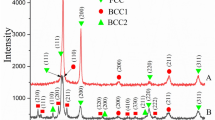Abstract
The electron-beam melting process offers the potential of purifying high-melting-point materials because of the high temperatures and vacuums attainable. The results of studies of the effects of electron-beam melting on metals and compounds are presented. The metals evaluated were: beryllium, boron and boron alloys, cobalt, hafnium, tungsten, and vanadium. The compounds included: titanium carbide, tantalum carbide, and zirconium di-boride. In addition, deoxidation studies were carried out on beryllium, molybdenum, and vanadium and the results obtained are presented.
Similar content being viewed by others
References
The Metal Beryllium, American Society for Metals, Novelty, Ohio, 1955.
H. T. Sumsion and C. O. Matthews: Vacuum Melting of Beryllium by Electron Bombardment, Vacuum Metallurgy Conference, 1959, New York University Press.
A. Calverly and A. Lauley, Proceedings on First Symposium on Electron Beam Melting, Alloyd Research Corp., Watertown, Mass., March 20, 1959.
Development of Cobalt-Base Alloys, Armour Research Foundation, project no. B131, contract NOa(s) 58-136-C, Oct. 29, 1958.
Correspondence with J. T. Perryman, Stauffer-Temescal Co., July, 1960.
J. P. Coughlen: Contribution to the Data on Theoretical Metallurgy, Part XII, Heats and Free Energies of Formations of Inorganic Oxides, Bulletin 542, Bureau of Mines, 1954.
Kubaschewski and Evans: Metallurgical Thermodynamics, John Wiley & Sons, Inc., New York, 1956.
E. J. Ripling, Tensile Properties and Rheotropic Behavior of Titanium Alloys and Molybdenum, WADC TR 55-5, May, 1955.
K. C. Dike and R. A. Long: Effect of Processing Variables on the Transition Temperature, Strength, and Ductility of High-Purity, Sintered, Wrought Molybdenum Metal, NACA Technical Note, 2915, March, 1953.
Author information
Authors and Affiliations
Additional information
This research was supported by the USAF under contract no. AF-33(616)-5603, monitored by the Materials laboratory, Wright Air Development div., Wright-Patterson AFB, Ohio.
Rights and permissions
About this article
Cite this article
Seagle, S.R., Martin, R.L. & Bertea, O. Electron-Beam Melting. JOM 14, 812–820 (1962). https://doi.org/10.1007/BF03378197
Published:
Issue Date:
DOI: https://doi.org/10.1007/BF03378197




